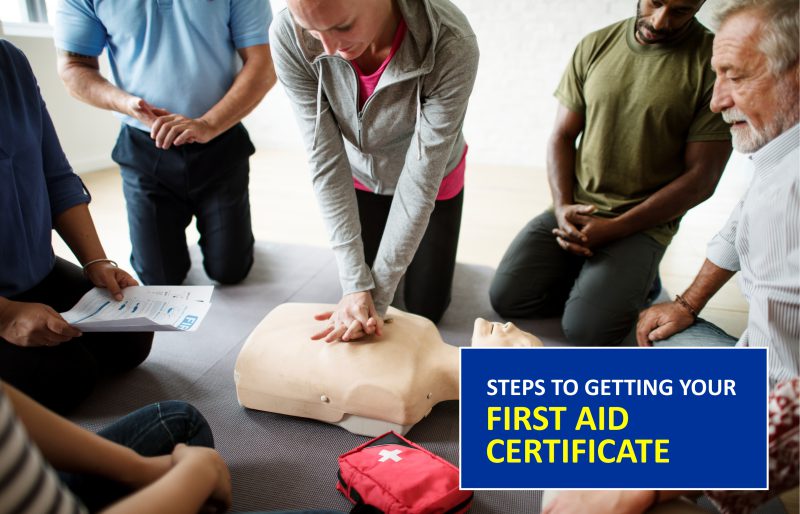5 Steps to Getting Your First Aid Certificate
Whatever your line of work, knowing how to administer first aid is a valuable skill. First aid certifications are essential for working in childcare and with school-aged children. If you are able to administer first aid as soon as possible and correctly in most of these cases, you may be able to save someone’s life. Always be prepared with the knowledge you require.
The majority of Australians lack basic first aid skills. According to the Red Cross, less than 5% of people, one of the lowest rates in the world, have first aid training. Even if things are getting better, Australians need to do more to prepare for first aid.
The good news is that those who want to increase their practical knowledge can easily find first aid training programmes and chances. The seven basic procedures of first aid are one of the first core concepts covered by first aid certificates. First aid is just what it sounds like: first aid. That is, the initial aid offered in the event of a disease, injury, accident, or medical emergency. You can know what to do if you are the first person on the scene thanks to first aid training.
Step 1: Pick the Appropriate Course for You
Select the first aid training course that best meets your needs. Your choices are as follows:
- HLTAID011 – Provide First Aid
After successfully completing the unit, students will be able to demonstrate the abilities necessary to respond to a casualty with first aid in accordance with standards established by the Australian Resuscitation Council. The unit is applicable to anyone who might need to respond with first aid in a variety of settings, such as the community and the workplace. - HLTAID009 – Provide Cardiopulmonary Resuscitation (CPR)
After successfully completing the unit, the student will be able to demonstrate the knowledge and skills necessary to perform cardiopulmonary resuscitation (CPR), manage and assess an emergency, use an automatic external defibrillator (AED), and comprehend DRSABCD and the First Aider’s legal obligations. This unit applies to everyone who might need to perform CPR in a variety of settings, including the community and the workplace. - HLTAID010 – Provide Basic – Emergency Life Support
After successfully completing the unit, students will be able to showcase the knowledge and skills necessary to recognise and address life-threatening emergencies in accordance with first aid recommendations made by the Australian Resuscitation Council (ARC) and other Australian national peak clinical bodies.
Step 2: How to Book your Seat
Once you have decided on a first aid course, you can either book it right away or contact us with any queries you may have. You can also ask counsellor for assistance during the entire process, giving you the confidence to launch your first certificate course. From a variety of possibilities, pick the time and place you want.
Step 3: Complete Your Prerequisite Process on Campus or Online
The online process will help you along the way and make completing your first aid training quick and easy. You can even visit the campus if you want the admissions process to go smoothly or if you are more interested in handling it yourself. Keep in mind that you can contact us if you have any problems because we are always willing to assist.
Step 4: Workshop and On-the-Job Training
You must show up for your workshop and the planned first aid training after finishing your pre-learning. This is actually enjoyable since it allows you to use everything practically that you have learned and develop a full understanding of how to give first aid in a number of scenarios.
Step 5: Continue to Renew It
After completing a First Aid course, you might believe you are prepared for life. Even if it is mostly accurate, taking only one course will not guarantee your life safety. Knowledge and talents can really deteriorate over time, unlike many other abilities. When it comes to first aid, skipping even the smallest step or detail puts the person at risk and you would never want it to happen.
Your confidence might be damaged if you do not know what to do in an emergency. Hence. the stringent requirements of the Australian Resuscitation Council (ARC) for CPR certification renewal every 12 months are mandatory.
Way Forward
Emergencies are unavoidable and frequently occur when we least anticipate them. When someone needs emergency medical care, we should never be unprepared or passive. When dealing with emergencies, sound judgement and quick action are crucial.
Taking a first aid course can also help with the development of abilities and skills. Check out the first aid training courses offered close to you or get in touch with us for a course schedule if you simply want to learn some skills to keep a loved one safe rather than because you need a course for work. Then, experience these advantages for yourself right now.
People Also Ask:
Related Blog: Emergency Care and First Aid for Nurses


